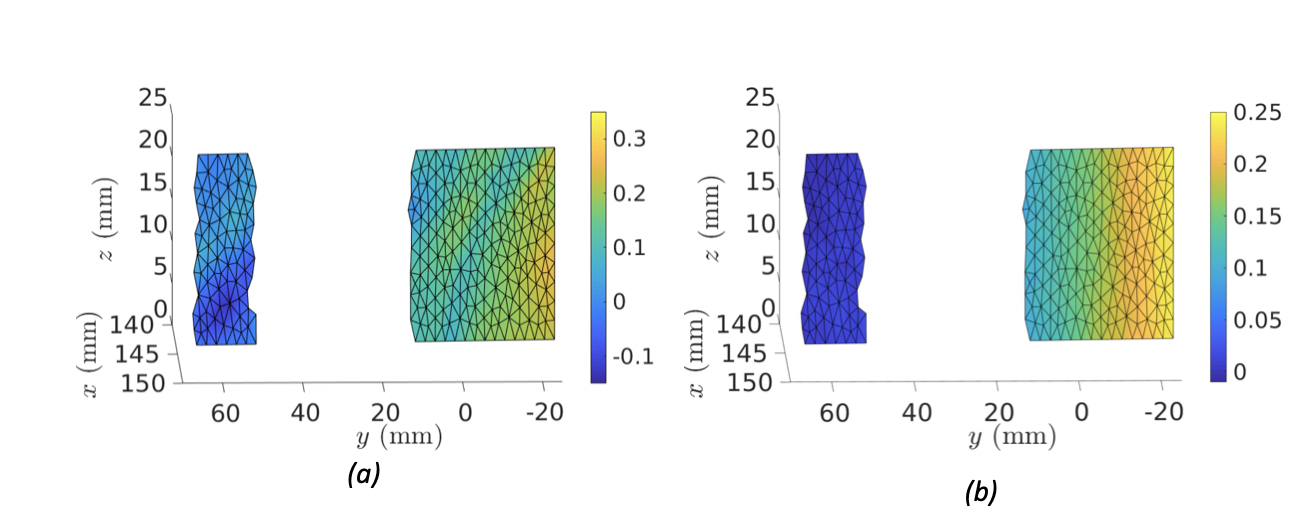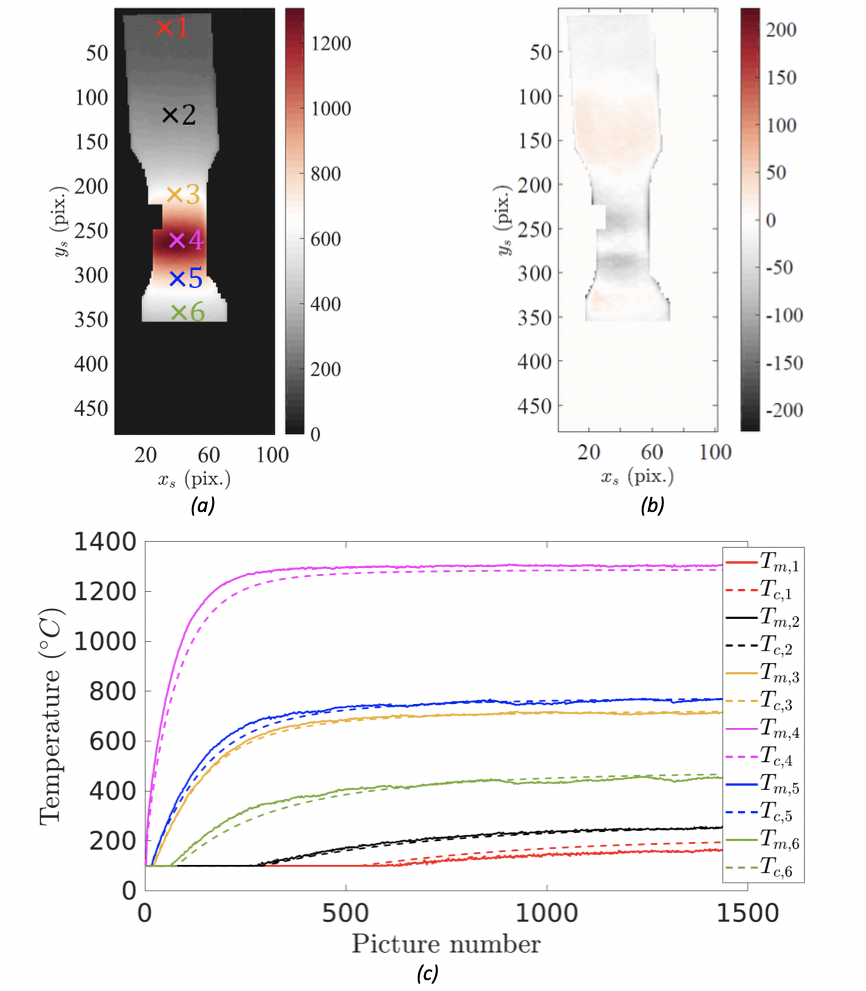High-temperature tests for ceramic matrix composites
- By Myriam Berny, R&D engineer at EikoSim
As a new member of EikoSim team, I was offered the opportunity to present an overlook of my thesis work dealing with high-temperature experiments for SiC/SiC composites, which was carried out in LMT under the supervision of F. Hild and in collaboration with Safran Ceramics under the supervision of V. Herb and B. Lacombe.
Credits : Myriam Berny, R&D engineer, PhD student.
Safran Ceramics are striving to increase their technical skills regarding the analysis and understanding of the thermomechanical behaviour of coated and uncoated Ceramic Matrix Composites (CMCs) for gas turbine engine applications. Experiments performed in more representative in-service conditions of engines are required to achieve this purpose. Thus, it calls for high-temperature tests (i.e., greater than 1,300°C) on specimens under intense 3D thermal loading that are multi-instrumented by infrared and visible light cameras (Fig.1.) to control the thermal and kinematic boundary conditions and understand the material behaviour. Thus, the objectiveof my thesis was to develop different procedures to assess the thermomechanical behaviour of CMC materials at elevated temperatures, using thermal and kinematic full-field measurements and correlations between experiments and Finite Element (FE) computations.

High-temperature experiments on BNMI-SiC/SiC composites present different challenges. First, the material exhibits small levels of strain (i.e., less than 0.1% in the reversible domain) and a heterogeneous behaviour, which implies to use full-field techniques able to monitor the thermomechanical response and measure small amplitudes of displacements. These requirements lead to the use of infrared thermography and DIC/stereoDIC methods, based on infrared and visible light cameras. However, elevated temperatures induce several additional challenges such as black body radiation and convective currents that are especially prejudicial for DIC measurements. Thus, high-temperature DIC analyses require dedicated strategies to account for grey level variations and mitigate the heat haze effect that distorts the images and impairs the displacement measurements.
To identify CMC properties based on images acquired in such challenging environment, several steps were followed. Firstly, the relationship between the measurements acquired from 2D images and the thermomechanical computed fields coming from 3D FE simulations was established. Two procedures were proposed to calibrate the different cameras used in the experiments (i.e., the projection matrices). On one hand, the calibration of a single IR camera was implemented based on self-calibration method. On the other hand, the calibration of a stereo rig in a global stereoDIC framework thanks to an in-situ speckled calibration target (tailored for the experimental setup) whose surface FE model is well-known and a single pair of images. The different calibration procedures, which are proposed by EikoSim in EikoTwin DIC for visible light cameras and in a thermal add-on for IR cameras, allowed for Lagrangian measurements of thermomechanical fields. In addition, it enabled for potential assessment of small amplitude displacements (e.g., 2 µm for longitudinal component) at room temperature, which is a primary requirement for the analysis of mechanical behaviour of CMCs.
After calibrating the cameras, the thermomechanical fields at high temperatures were discussed to assess the ability of measuring reliable temperatures and displacements despite convection effects. Spatiotemporal fluctuations due to heat haze were shown to corrupt the sought measurements. Modal analyses were performed on temperature fields to assess the contributions of the different phenomena (i.e., heating process, convective effects and acquisition noise) and establish the thermal uncertainty levels and covariance matrices for the IR cameras used in this study. Furthermore, quantitative analyses were conducted to characterise the heat haze effect and its consequences on displacement measurement quality in terms of fluctuations (i.e., significant increases).
These observations led to the conclusion that dedicated spatiotemporal regularisation strategies are necessary to deal with the high level of fluctuations of 2D and 3D surface displacements measured respectively with 2D-DIC and Finite Element based stereoDIC (FE-stereoDIC). Such procedures were applied to several high-temperature experiments on CMC specimens. The common characteristics of the developed global spacetime DIC and stereoDIC algorithms is the modal decomposition of the kinematic fields parametrised with separated space and time variables (i.e., temporal and spatial shape functions). Regarding spacetime 2D-DIC, two implementations were investigated depending on the chosen temporal parametrisation, namely an a priori parametrisation and an “on-the-fly” construction of the modal basis through Proper Generalised Decomposition framework. The latter was in addition extended to deal with spatiotemporal brightness and contrast corrections, which are required to correct the effect of black body radiations that occur at elevated temperatures. Furthermore, a denoising procedure for the reference image was proposed. Spacetime regularisation was also developed for FE-stereoDIC through minimal changes, thanks to prescribed temporal bases, modal decomposition and non-intrusive algorithmic schemes. These strategies were applied to the analysis of large image series and were proven to be efficient to mitigate heat haze effects (Fig.2, Fig.3.).


Thus, consistent and reliable 2D and 3D displacement fields were measured on CMC surfaces at temperatures greater than 1,300°C, with reduced temporal and spatial fluctuations that reached a level much lower than that enabled by the physical addition of a fan on the test set-up, which is commonly used in the literature to mitigate heat waves.Consequently, the unified spacetime framework appears beneficial for DIC analyses on CMCs at very high temperatures.
The final step for this research work was the development of a generic identification algorithm based on weighted temperature and kinematic functionnals (called weighted FEMU-TU), using close framework to that proposed in EikoTwin Digital Twin for kinematic and load data. Weighted FEMU-TU is based on full-field temperatures and displacements (2D / 3D surface) and accounts for measurement uncertainties (through covariance matrices) to identify the thermal boundary conditions and thermomechanical properties of SiC/SiC composites under severe 3D thermal loading. The measurement space and time bases being chosen as reference, computed fields and sensitivities were projected onto these bases, using in particular the calibrated projection matrices. Thus, measured and computed thermomechanical fields were “properly” compared. In addition, regularised displacement fields were used thanks to the spacetime strategies introduced to minimise the effect of heat haze. On the other hand, the calibration of a stereo rig was performed in a global stereoDIC framework thanks to an in-situ speckled calibration target (tailored for the experimental setup). By combining all these procedures, the identification of the sought parameters was achieved with very satisfactory results for each of the four analysed experiments. In particular, the success of the identification on real experiments was highlighted by the low level of thermal (Fig.4.) and kinematic residuals (i.e., the difference between measured and computed fields) compared to the measurement fluctuations and noise-floor.

Conclusion
To conclude, a complete and robust procedure was developed to deal with high-temperature tests on CMCs, from the measurements to the identification of thermomechanical properties. These developments were performed to reduce the effect of elevated temperatures and increase the reliability of thermal and kinematic measurements, so that the parameter identification is carried out with minimum impact of measurement fluctuations. These precautions led to a more reliable assessment of thermomechanical response of SiC/SiC composites tested at high temperatures.
